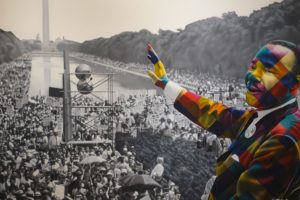Miami, Apr 16 (EFE).- Although he opened his first solo exhibition in the United States in a Miami gallery, Brazilian graffiti artist Kobra never forgets where he started and says the world’s leading museum is the street, where he has painted so many works full of color and social consciousness.
“I’m privileged to be able to exhibit in the street – my work is already on show in the world’s principal museum, the principal art gallery, which is the street,” he said.
This month the artist opened at the GGA Gallery in Miami’s Wynwood arts district his one-man show dubbed “Kobra: Larger Than Life,” a collection that was almost entirely sold out before the inauguration of the exhibit.
These 32 large-scale pieces echo murals he has created around the world with a mixture of his typical humanitarian messages, historical scenes and environmental concerns, including some new pieces never before presented to the public.
He’s happy because, though this is a gallery, it’s a kind of open public space that some 5,000 to 15,000 people from all over the world pass through daily on their visits to this trendy neighborhood located just north of downtown Miami.
Wynwood, in fact, has become in recent years a “relevant setting for urban art.”
The 44-year-old Eduardo Kobra started painting in the streets of Brazil in 1988 and since then his work has reached some 30 countries on five continents.

Before he begins painting on walls, the graffiti artist makes a study in which he tries out the color combinations on a canvas often similar in size to the final work, and those canvases are what make up his Miami exhibition, scheduled to remain open until next July 1.
What he had already painted locally is “Ethnicities,” a mural measuring 140 sq. meters (150 sq. feet) in Wynwood that he created for Art Basel Miami Beach 2018, and which portrays five children from the five continents representing the diversity of their cultures.
Kobra said that, as in the case of “Ethnicities,” the works in his South Florida exhibition continue to advocate tolerance and the union of peoples, the protection of the environment, of wildlife and of peace.
The Brazilian, one of the most famous muralists in the world, emphasized the importance of exhibiting in galleries to make sure his work lasts over time, since street murals are “ephemeral,” time does not pardon and the works get damaged as the years go by.
With all that, the graffiti artist is categorical in saying that despite his wish to “survive,” he has no wish to abandon street art: “Painting in the streets will always come first.”
Kobra consequently said that while he can, he will continue painting in the streets where he became an artist, like those in the “simple” Sao Paulo suburb where he grew up, but of course combining it with traveling exhibitions and shows like the one in Miami.
The thing is, he said, street art is what has given him the “privilege” of traveling the world and getting to know the many cultures and customs that later become the subjects of other murals.
In this year of 2019 he has been invited to paint in 30 countries, and though he acknowledges that it will be impossible to accept all the offers, he will do everything possible to organize his agenda to take his art everywhere that is humanly possible.
The ideas he expresses on walls worldwide are born of a study of local history and of famous individuals who achieved something important for “humanity, in favor of peace.”
With those ideas, he said, he seeks to “modify” the mentality of society, especially of young people, and speak to them of tolerance and of the fight against racism and violence.
“Art changes the community, the city and improves the urban environment and offers many benefits,” Kobra said about some murals, which, from his point of view, are the “most democratic version of art.”
